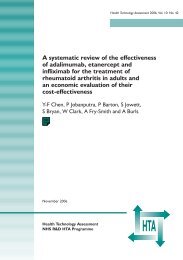Measuring Athlete Imagery Ability: The Sport ... - ResearchGate
Measuring Athlete Imagery Ability: The Sport ... - ResearchGate
Measuring Athlete Imagery Ability: The Sport ... - ResearchGate
Create successful ePaper yourself
Turn your PDF publications into a flip-book with our unique Google optimized e-Paper software.
436 Williams and Cumming<br />
is most appropriate for the upcoming intervention. For example, the SIAQ should<br />
be used if the intervention encompasses sport related images whereas the VMIQ-2<br />
or MIQ-3 would be preferred if separate assessment of both visual perspectives<br />
is needed or if the intervention includes imagery of movement content that is not<br />
sport related. Separately assessing different types of imagery ability at the outset<br />
enables researchers to tailor the content of an imagery intervention to be reflective<br />
of the type of imagery an athlete is most capable of performing.<br />
<strong>Athlete</strong>s of a higher competitive level found it significantly easier to generate<br />
sport images. Although various studies have established competitive level differences<br />
as a result of movement imagery ability (e.g., Gregg & Hall, 2006; Roberts<br />
et al., 2008), very few have demonstrated the influence competitive level has on<br />
imagery ability of sporting content. Research has identified athletes competing at<br />
a higher level use imagery more frequently (e.g., Hall et al., 1998), and athletes<br />
who use imagery more frequently, tend to display higher levels of imagery ability.<br />
Consequently, athletes of a higher competitive level would be expected to be able<br />
to generate images with greater ease than their lower level counterparts. <strong>The</strong>refore,<br />
as well as extending previous research, this finding further validates the SIAQ as<br />
a measure of sport imagery ability.<br />
<strong>The</strong> SIAQ’s temporal reliability was supported by test-rest reliability over a<br />
3-month period suggesting any increases in reported SIAQ scores following an intervention<br />
of three months or less are likely to result from improvements in imagery<br />
ability. Study 4 established the SIAQ’s concurrent validity and demonstrated that<br />
imagery ability reflected by one questionnaire will not necessarily generalize to<br />
another. Both the SIAQ and the MIQ-3 assess imagery ability in terms of ease of<br />
imaging on a similar 7-point Likert-type scale. This provides further support for<br />
the suggestion that discrepancies between the two questionnaires are a result of<br />
differing content rather than other factors such as the construct of imagery ability<br />
being assessed or the discrepancy in the rating scales.<br />
Development of the SIAQ has opened various avenues of future research. As<br />
a new questionnaire, it should undergo further validation. Although the SIAQ has<br />
been compared with the MIQ-3 as a measure of imagery ability, there are other<br />
valid and reliable imagery ability questionnaires such as the VMIQ-2 that assess<br />
other characteristics of imagery ability (e.g., vividness). Because the SIAQ evolved<br />
from the five types of imagery identified by the SIQ (Hall et al., 1998), it would also<br />
be logical to examine relationships between the SIAQ and SIQ subscales in future<br />
research. In addition, potential moderating effects of imagery ability, proposed by<br />
the applied model of imagery use (Martin et al., 1999), can be more extensively<br />
examined due to the SIAQ’s capacity to assess different types of imagery outlined<br />
in the model.<br />
Finally, as well as performance improvements, imagery has been associated<br />
with various motivational processes and outcomes (for review, see Cumming &<br />
Ramsey, 2009). With the existence of a valid and reliable questionnaire providing<br />
a comprehensive assessment of the ability to image athlete imagery content, the<br />
relationship between imagery ability and psychological characteristics associated<br />
with sporting success/failure can be more extensively explored.<br />
In conclusion, the present investigation established and validated a reliable<br />
questionnaire assessing skill, strategy, goal, affect, and mastery sport imagery<br />
ability, the content of which reflects the five functions of imagery used by athletes
















